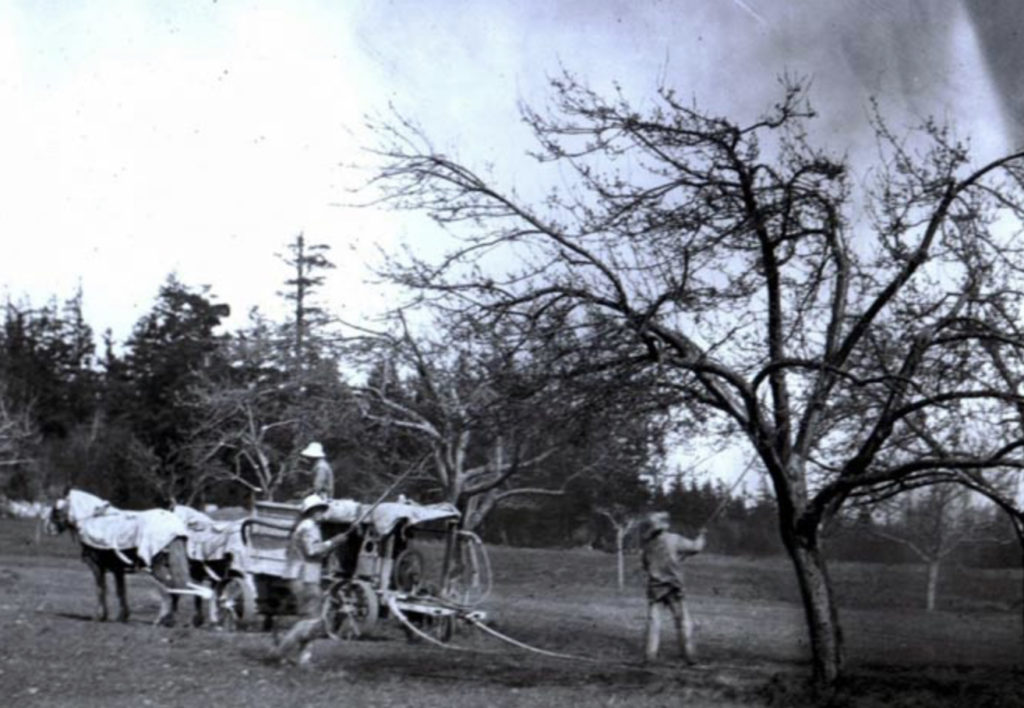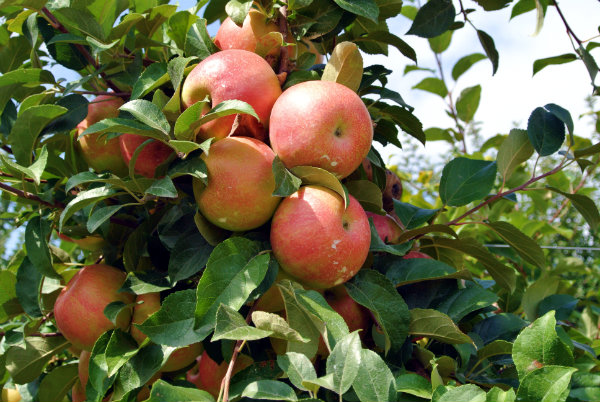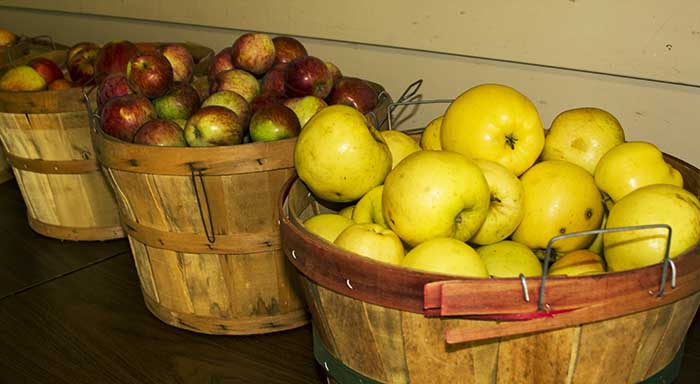The San Juan Islands are a living museum of historic American apple varieties
by Madrona Murphy, Kwiaht

Apples may well be the most long-standing crop grown in the islands, as native Pacific crabapples were harvested and tended by the Coast Salish families that were the islands’ original inhabitants. When planting orchards became a way of “proving up” property for homesteading, these same native families planted some of the first domestic apple orchards in the islands as well, including the Cayou orchard on Orcas, which was planted by Coast Salish homesteader Mary Anne Cayou and her French-Canadian husband Louis in the 1860s.
Apples are long lived, and well adapted to our maritime climate, and many of the orchard trees planted in the islands in the 1860s to early 1900s are still standing and still productive. Since 2011 Kwiaht has been mapping old island orchards, identifying heritage varieties, and evaluating the many seedlings varieties that have sprouted in these ancient food forests. The islands’ oldest orchards produce American heritage apples that are well suited to our climate, reflect the tastes of apple buyers in the 1890s and early 1900s, and for the most part are virtually unknown in the rest of apple growing Washington.

Of all the heritage varieties planted in the islands, the most popular, both when orchards were established, and to this day, is the King, also known as King of Tompkins County. Large, highly colored, sweet and fruity, Kings are also loved for their versatility. They are excellent fresh as dessert apples, can be baked or sauced, robust enough to give body to both sweet and hard ciders, and keep well for fresh eating in the winter. They are also typical of island apples—they originated in New
Jersey around 1750 but are far more popular in the islands than in the apple growing regions in New Jersey and New York where they originated.
As large, or larger than Kings, and often planted alongside them since they have similar bloom time, is Twenty Ounce, also known as Twenty Ounce Pippin. Similarly high colored and striped, Twenty Ounce are rounder, tarter, and more delicate fleshed than Kings, but considered a better baking apple. The term pippin indicates that this variety was developed from a seedling (a pip is a seed) rather than as a sport on an established variety. Twenty Ounce apples originate in New York in 1840, and have been grown in the islands since at least 1896 (from research by Boyd Pratt, 2018).

The third large striped apple common in old island orchards is one of the few non-American varieties: Gravenstein. These large striped apples are distinctly sweet-tart and relatively tender fleshed, making them primarily suited to local markets as they bruise in shipping. They bloom very early and one of the reasons that Twenty Ounce may have been popular in old island orchards is that its blooming overlaps with Gravenstein for good pollination. Gravensteins as a type of apple originate in Europe, but they are more of a category than a distinct variety, with numerous Red Gravenstein varieties make unique fermented ciders, and distilled into local apple spirits.
Although most of the heritage apples in the islands are striped, there are exceptions, many, if not most, old island orchards also include Rhode Island Greening, which is large and green, occasionally with a reddish blush. Primarily used for cooking, Greenings are not too tart to be enjoyed fresh, but tart enough to add acidity to ciders. Greenings are a very old American variety, originating in Rhode Island around 1650. Rich in pectin, Rhode Island Greening makes a super rich and smooth apple butter.
Kings, Twenty Ounce, Gravensteins, and Rhode Island Greenings are widely distributed in island orchards, and are varieties that many islanders recognize; but our ancient island orchards also include less well known American apple varieties such as late ripening Blue Pearmain. Blue Pearmain ripens to dark red, nearing purple, and has a waxy bloom that makes it appear blue when ripe. Blue Pearmain apples are beautiful and flavorful, and it is surprising that they are not better known. Two varieties of Russet apple grow in old island orchards, where they are often mistaken for one another. Roxbury Russet is arguably the oldest American apple variety, developed in Massachusetts prior to 1649. Roxbury Russets are green apples that are covered all over with a coat of rough brown russet, giving them a sandpaper texture. The flesh is dense, dry, and very sweet with nutty flavor. The high sugar and acidity make them well suited to fermenting and distilling, or to eating sliced alongside cheese. In some of the oldest orchards on Lopez (planted before the first topographic maps in 1889) there are also Brown Russets. More conical, later ripening, and with a distinctly open calyx (the remains of the flower on the bottom of the apple), the origin of this variety is mysterious, and the islands may be one of the few places they are grown. Sweet and dense like other russets, they also produce a clear golden juice that does not turn brown like most fresh cider.
Wagener is an apple grown in old island orchards that has lost its place in commercial fruit growing due to changing tastes—it is an apple that needs to finish ripening and mellowing off of the tree before being eaten. At a time when storage apples were highly valued, Wageners were popular in the Northeastern market. With the enduring popularity of Gravenstein, it is somewhat surprising that Yellow Bellflower is not a better known and loved apple variety. It may be their outer resemblance to Golden Deliciouis and lack of high color, but bite into one and you’ll find that Bellflowers have the same bright sweet tart balance of Gravensteins, with a firmer texture and better keeping qualities. A New Jersey variety introduced before 1742, Bellflowers are excellent cider apples that are also good fresh and bake nicely.
A few of the apples planted in the islands are particularly prized for their use in making hard ciders, though unlike French and English cider apples, these American apples are not too tannic to be eaten fresh or baked with if need should arise. The more common of these is the Baldwin apple, once widely planted in New York and New England, it proved to be better suited to our mild winters and has continued to grow in island orchards while East Coast trees have died in particularly nasty winters. Baldwins are red apples with pretty stripes and some russetting around the ends. Mammoth Black Twig, the other island cider variety, is larger, and less well suited to fresh consumption—it is tart and bitter when fresh picked, and loses much of its flavor in storage. This same acidity and complex tannins make it a perfect component in fermented ciders.
The unusual American heritage apples grown in the San Juans are not the only apples unique to our archipelago: both our old farms and our roadsides abound with seedling trees sprouted from fallen or discarded apples that represent a truly unique genetic mix and are perfectly adapted to the islands climate. These island apples also bring us back to the origins of apple growing in the San Juans, as they include hybrids with the native crabapples so prized by Coast Salish families. Very few of the seedling varieties have been evaluated or propagated, but in our mapping we have found sweet crunchy striped apples the size of gumballs, an early ripening yellow apple that tastes like rosewater, a medium-sized striped apple with a heady grape fragrance, a large yellow apple that makes fantastic spiced apple preserves, and many apples that have either the tannins or the acidity to improve locally made hard ciders.
*
Madrona Murphy is a botonist associated with Kwiáht, a nonprofit conservation biology laboratory in and for the San Juan Islands of Washington State. Find out more at www.kwiaht.org.
